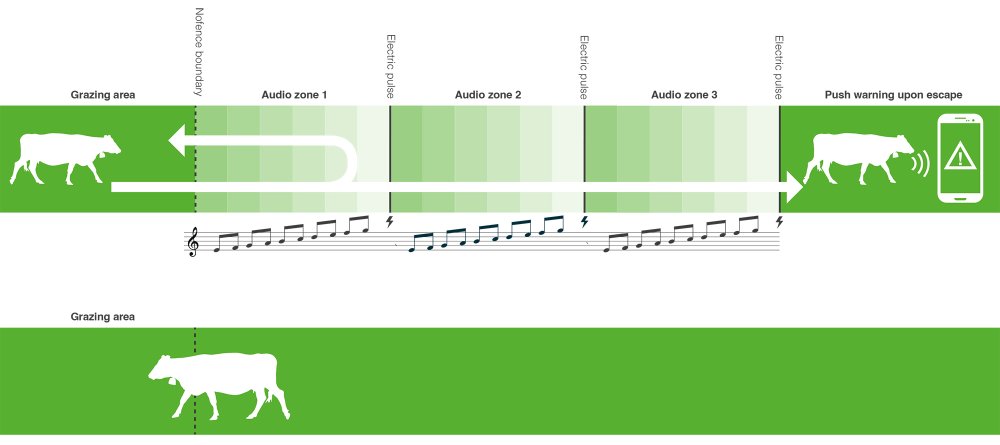How is it possible to fence animals with virtual grazing technology?
To keep animals within the virtual pasture boundary, Nofence uses two important elements: Their sense of hearing and their herd instinct. The animals use their hearing ability to identify where the boundary is, and the herd instinct makes them turn around and return to the pasture and the rest of the herd when they hear the audio cue.
The pasture boundary
When the animal crosses the Nofence boundary, the collar emits an audio cue. The audio warning starts at a low cue, which gradually increases as long as the animal is outside the boundary. The animal recognizes this audio cue, turns around, and returns to the pasture to avoid the electric pulse.
The illustration shows the desired behavior. The animal leaves the pasture, responds to the audio cue, turns around and returns to the pasture.
If an animal escapes and keeps walking away from the pasture, it will receive a total of three audio zones. After the third, the fence function will switch off, and the audio cue and electric pulse will be deactivated. The farmer will be alerted with a push notification via the Nofence app. The collar will keep reporting its position even though the animal is outside the pasture, so you will know where the animal is at all times. When the animal returns to the pasture, the fence is reactivated and the farmer will be notified that the animal has returned.

The illustration above demonstrates what happens if the animal chooses to escape. A maximum of three electric pulses are emitted before the animal is registered as escaped and the fence function is switched off. The fence function is reactivated once the animal returns to the pasture.
The boundary extent
The electric pulse is only to be emitted if the collar has played all the audio cues in the audio warning. The reason for this is that the system should be predictable and manageable for the animal. It takes at least 5 seconds, and a maximum of 20 seconds to play the audio cue, depending on the animals speed away from the boundary. If the animal crosses the boundary at high speed, the audio cue will play at fast speed. On the other hand, it will play at a slower speed if the animal is crossing the boundary at a reduced speed. This should be considered when fencing the animals close to a road, especially if the pasture is on a hill so that the animal can move towards the road at a faster pace.
The audio zone is affected by the GPS signal. Poor position accuracy will make the boundary less accurate, and the audio cue can start sooner or later than where the actual boundary line is in the map. If the GPS signal is so poor that the accuracy is less than 3.5 meters, the collar will not emit any audio cues or pulse.
You may experience that the audio zone has a larger variation when the collar is in teach mode vs standard operating mode. Animals that know the system well, know that they can “stop” the audio cue more easily while the collar is in training mode. You can read more about the different operation modes in the chapter Training animals.
If you test the collar yourself while crossing the boundary, you can experience how the audio cue starts and stops at different speeds. While doing this, please remember to hold the collar correctly, to avoid receiving an electric pulse. Hold the collar by the neck strap, and make sure that you are not touching the chain.




